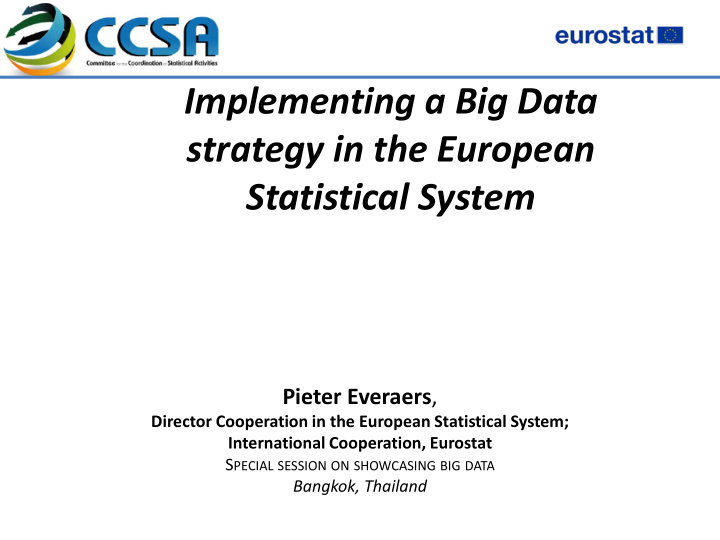



Implementing a Big Data strategy in the European Statistical System Pieter Everaers , Director Cooperation in the European Statistical System; International Cooperation, Eurostat S PECIAL SESSION ON SHOWCASING BIG DATA Bangkok, Thailand
Eurostat / ESS experience High level actionable commitment Engage stakeholders within the European Commission Raising awareness within Eurostat and the ESS
Current state ESS Scheveningen Memorandum on Big Data Eurostat Task Force Big Data and ESS task force Big Data Big Data Roadmap and Action Plan 1.0 Big data Vision Implementation Project Legal, ethical aspects, communication, skills and training, information exchange ESS Pilots Engage stakeholders European Commission Communication "Towards a thriving data driven economy" Implementation of ESS Vision 2020 Big Data roadmap and action plan integral part of portfolio
Scheveningen Memorandum Examine the potential of Big Data sources for official statistics Official Statistics Big Data strategy as part of wider government strategy Address privacy and data protection Collaboration at European and global level Address need for skills Partnerships between different stakeholders (government, academics, private sector) Developments in methodology , quality assessment and IT Adopt action plan and roadmap for the European Statistical System
Roadmap "As is" versus "To be" Long term Vision > 2020 Medium term aims BY 2020 Short term objectives BY 2016
Short-term objectives Official statistics integrated in the Commission big data strategy Identification and analysis of output portfolio of big data sources Pilot projects Skills and ESS professional training programmes are established Research lines on big data included into the 2016-2017 Work Programme of the Horizon 2020 Research Framework Programme Communication to the general public on big data activities Exchange of information with stakeholders within the statistical system and the research community
Medium-term objectives Official Statistics integrated in governmental big data strategies at national levels across the ESS Pilots are finalised Adequate IT infrastructures and methodological and quality frameworks are available , data science skills integral part of official statistics education Public Private Partnerships are in place on big data and Official Statistics. Ethical guidelines and communication strategy
Long-term objective Big data sources integrated in ESS official statistics production
The ESS Big Data Action Plan P I L O T S Policy Legislation Ethics / Communication Quality Skills Methodology IT Infrastructure Experience sharing
The ESS Big Data Action Plan Process Communication WWW Sensors Crow d sourcing generated data Volunteered Mobile phone Flight Booking geographic Web Searches Traffic loops data transactions information (VGI) Community Businesses' Supermarket Social Media Smart meters pictures Websites Cashier Data collection E-commerce Vessel Financial websites Identification transactions Job Satellite advertisements Images Real estate websites
Blending of Sources and multipurpose Statistics Mobile Tourism phone Statistics data Commuting Population Statistics Statistics Mobile Population Satellite Smart Phone Images Meters Statisics Data Traffic Migration Statistics Statistics VGI w ebsites
Risks in the use of big data for producing official statistics Risks identified in the Action Plan and Roadmap Difficult access to data Negative public perception Skill shortages … Eurostat suggested approach Structuring risks and solutions Analysis based on a quality framework Collection of additional risks via survey among experts Likelihood and Impact of risks by source
Raising awareness Engage the stakeholders within the European Commission Cooperation at International level Competition (Nowcasting) Hackathons
Engage stakeholders within the European Commission Data, Information and Knowledge Management at the European Commission Active cooperation with several policy DGs Recognising a central role for the ESS Towards a common Big Data Strategy supported by appropriate IT infrastructure and skills Data4Policy inter-departmental group Applications oriented interdepartmental group Fostering collaboration with policy departments and the Joint Research Center (JRC) on concrete applications of using big data for policy.
Global Working Group on Big Data for Official Statistics High-Level Group for the Modernisation of Statistical Production and Services , Task Teams working on: Pilots Indicators for monitoring Sustainable Development Goals Advocacy and Communication Access and Partnerships Quality, Methodology, Taxonomy Inventory Collaboration with the UNECE Sandbox environment
Competition (Nowcasting) Format Collect predictions before official release is out. Repeat for several periods and finally compare performance. Purpose Provides an evaluation forum for methods and sources and their applicability for statistical purposes Raise awareness within the scientific community of problems faced by the statistical system Application domains Any statistical indicator which is frequent and stable enough can be used including SDG related ones Expected launch: Autumn 2015
Hackathons Format and purpose Get together for a day (or a night) or two, work intensely on a problem Get to know about specific problems, get to know people, come up with innovative solutions Traditionally done in computer science Application domains For Eurostat it was nowcasting unemployment with data from Google Trends Many other possibilities exist including SDG related indicators
The statistical office of the future Data flows instead of surveys and censuses Data customer instead of data provider Product designers instead of data collection designers New answers related to Quality and transparency Privacy and confidentiality Access to third party data sources / data sharing Scientific standards and methodology Professional ethics Skills Accreditation and certification instead of production Embedded in data flow – statistics 'everywhere'
Recommend
More recommend